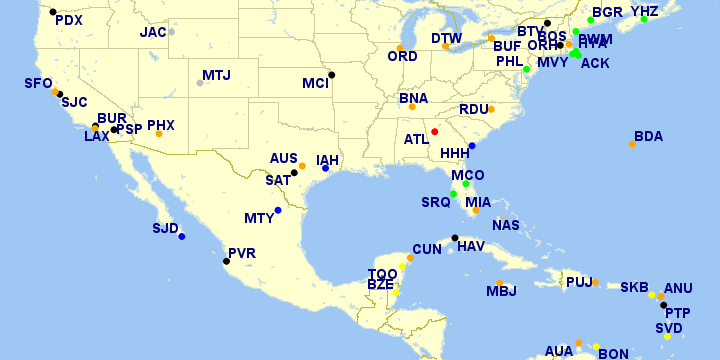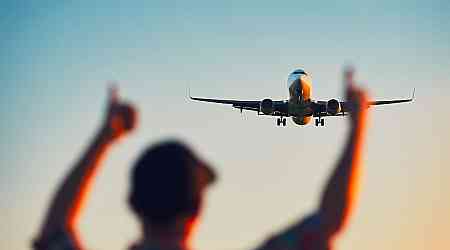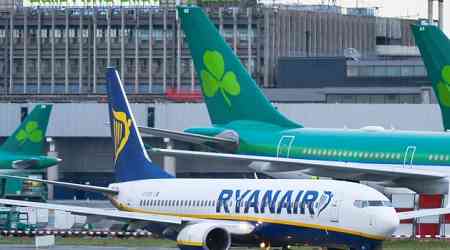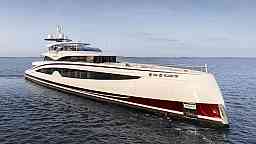An appeals court ruled last week that the American and JetBlue Northeast Alliance (NEA) was indeed anti-competitive, shooting down American’s attempt to overturn the original decision. But with the pending change in administration at the federal level and some comments that have been made about future partnering decisions in a different way, this seemed like a good time to go and take a look in Cirium data to see just what has transpired.
I’ve written exhaustively here about what was added when the NEA was being put together. In broad strokes, American bulked up on international from JFK along with a handful of domestic markets from LaGuardia, primarily in the Midwest and the Great Plains (Des Moines and Omaha, for example). It also eliminated 50-seat regional jets so it could have First Class and extra legroom available on all flights to/from NYC airports.
JetBlue, meanwhile, picked up the slack at LaGuardia where it launched flights to a dozen new destinations. It stretched into markets like Charleston (SC), Nashville, Portland (ME), etc. It went into new markets from JFK like Detroit, Kansas City, and San Antonio. This was about complementing each other.
But then, it all fell apart. Once the NEA was shot down by the feds, the airlines slowly unwound what they had done. JetBlue went back to serving the same four cities from LaGuardia it had served previously. American started flying more leisure routes again in order to try to keep those slots utilized both at JFK and LaGuardia. (It did also start leasing out slots to low-cost operators and doing some slot-squatting with Philly flights.)
To some, this was a victory because it meant that American and JetBlue could once again be considered competitors. To others, this made things feel less competitive because American and JetBlue were no longer able to compete on the whole with the behemoths Delta and United. But what really happened in detail? Let’s dig in.
I took a look at Q2 2024 vs Q2 2023 flying for both American and JetBlue. That captures the end of the spring break season as well as beginning of summer. It also shows the peak of the NEA which wasn’t shut down until May 2023. Schedules didn’t begin to change until after Q2. I also did something you might not love; I combined all three big New York airports. The way I figure it, I wanted to look at how many airlines serve the metro area this year versus last year before the NEA was ended. Looking at individual airports would create a lot of noise.
I tried to break this down into a cool map or some easy categories, but I struggled to do it. So, here’s a map that’s not all that helpful:

American/JetBlue Change NYC Routes map generated by the Great Circle Mapper – copyright © Karl L. Swartz.
Now, let’s talk about what each of these means.
The Atlanta ProblemAtlanta is a strange outlier, so it deserves a headline of its own. JetBlue served Atlanta from JFK, but it was in May 2023 that it went into LaGuardia as well. At the same time, American ended its LaGuardia service. JetBlue ended that service this October, but American has no plans to go back. This means that technically the number of competitors has remained flat in the broad metro since JetBlue still flies from JFK, but for that business traveler, there is really one less airline option now that neither is at LaGuardia.
American Exits, But Would They Have Stayed?There were three markets that American has exited since the end of the NEA:
Jackson Hole Montrose (CO) NassauThese were weekly routes for American that were primarily flown in winter. Now, American has left them all. JetBlue is in Nassau but not the others. Might American have stayed if the NEA still existed? Maybe, but probably not. These are heavy leisure markets that probably just didn’t pan out. My thought is that the NEA didn’t have much of an impact, and these would have disappeared anyway.
There’s one more market not mentioned here, and that’s Birmingham (AL). That was started at the end of the NEA, but it’s already gone. So, nothing to see there.
The End of the NEA and the Pandemic Brings American BackThere are three markets that American exited specifically due to the creation of the NEA, handing over the flying to JetBlue before coming back recently:
Orlando Nantucket Portland (ME)There are another four that ended after the pandemic began and have only recently returned:
Bangor Halifax Martha’s Vineyard PhiladelphiaDid these come back because the NEA was gone? On all but one, I would say yes. Orlando, Martha’s Vineyard, Nantucket, and Portland all now have JetBlue and American competing with each other. Those aren’t big markets, but it is an increase in competition post-NEA.
Bangor and Halifax aren’t served by JetBlue, so presumably American thought it had a better use for the slots elsewhere during the NEA. Now that the NEA is gone, it’s back in those markets.
Philly, well, that is just slot-squatting. During the pandemic, slot utilization rules were suspended so it didn’t need to fly. But now it needs to fly it once again.
I’ll also add two more to this group. They’re markets American didn’t serve in the NEA or before, but it has recently started flying:
Hyannis SarasotaHyannis is unrelated to the NEA. American was waiting for the runway extension to be finished before it went in there. But there may not have been slots available if the NEA was still in place, I suppose. In Sarasota, American can’t rely on JetBlue anymore, so it went into the growing market itself.
The American NEA Markets That Went AwayThere were six markets that American started due to the NEA and then exited as soon as it was done:
Doha (not on the map since it would have skewed the scale too much) Hilton Head Houston/IAH Kansas City Los Cabos MonterreyThese markets did not pan out, and as soon as the NEA was over, they were gone. Some may very well have been gone anyway, but without the NEA they don’t exist. As for Doha, that one moved down the road to Philly when it became clear that JFK would not be a big enough connecting hub without JetBlue.
Note, I’m not including Tel Aviv here at all, because it may very well come back when there is less of a threat from war. Call that one TBD.
JetBlue’s ExitsThe problem with JetBlue is that it is shifting its strategy under new management, so there has been a LOT of cleaning house. In this case, I have to look more recent than Q2 2024 to see the full extent of what is gone. Here’s what I’ve got, but there could be a couple missing:
Burbank Burlington (VT) Detroit Havana Kansas City Palm Springs Pointe-à-Pitre Portland (OR) Puerto Vallarta San Antonio San Jose (CA) Worcester (MA)Note that this doesn’t include the seasonal exits. Effectively what we have here is JetBlue walking away from some markets it held on to for reasons other than profit, like Burlington and Worcester which were not good performers but must have felt important to keep for one reason or another. The rest of these probably should have gone long ago and weren’t likely tied to the NEA but rather to the shift in strategy at the airline.
New Blue Crew RoutesWith all this, some new routes have emerged:
Belize Bonaire St Kitts St Vincent & the Grenadines TulumThese are deep leisure destinations that help to grow the airline’s footprint, but are they routes JetBlue would have flown otherwise? Tulum, probably, since JetBlue was only not at the airport because it had yet to open. But the rest are part of the broadened leisure strategy that might not have been possible if slots were dedicated to supporting the NEA’s business routes.
Partners to RivalsThe last grouping involves routes flown by both airlines before, during, and after the NEA. But since under the NEA they worked together and now they are once again rivals… some may consider this to be an increase in competition.
Antigua Aruba Austin Bermuda Boston Buffalo Cancún Chicago/O’Hare Detroit Los Angeles Miami Montego Bay Nashville Phoenix Punta Cana Raleigh/Durham San FranciscoShould we really count this as gaining a competitor? For the casual leisure traveler yes. But for the business traveler who cares about loyalty, it might just make both options less appealing.
It’s hard to say definitively that the NEA was or was not anti-competitive. It would certainly depend upon your point of view. If I’m a leisure traveler going to Orlando then great, it’s nice to have a 945th airline on the route again. But if I’m a business traveler to Atlanta, I’ve actually lost out.
I still find the argument to end the NEA to be a very strange one, but I am not a lawyer. The question now is whether or not the two airlines try to reunite in some form. Cirumstances are very different in almost every way now, so it’s far from a guarantee that this would be a good fit.
































